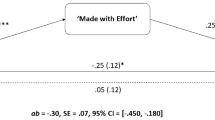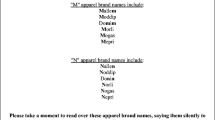Abstract
A critical component of brand equity is consumer perceived ethicality (CPE) of the brand. Yet, little is known about how to create positive brand CPE. We offer that the starting point for creating brand CPE is with the brand-naming decision. Drawing on sound symbolism theory, we propose that certain brand name characteristics better convey ethicality. Two studies are conducted. Study 1 finds that higher frequency sounds in brand names better convey ethicality than lower frequency sounds. Study 2 finds that brand names can positively impact brand CPE in the presence of additional information, in particular, information that reflects negatively on the brand’s ethical behavior. These results suggest that marketers be more involved at the onset of creating an ethical brand image.

Similar content being viewed by others
Notes
An anonymous reviewer indicated that subjects could have inferred semantic meaning from two replicates: “silk” in Silker and “gun” in Gunhark. After omitting both corresponding word pairs and reanalyzing, the results did not change substantively (Choice_aggregate = 69.1%, p < .001).
References
Aaker, J. L. (1997). Dimensions of brand personality. Journal of Marketing Research, 34(August), 347–356.
Aaker, J. A., Benet-Martinez, V., & Garolera, J. (2001). Consumption symbols as carriers of culture: a study of Japanese and Spanish brand personality constructs. Journal of Personality and Social Psychology, 81, 492–508.
Biehal, G. J., & Sheinin, D. A. (2007). The influence of corporate messages on the product portfolio. Journal of Marketing, 71(2), 12–25.
Brown, T. J., & Dacin, P. A. (1997). The company and the product: corporate associations and consumer product responses. Journal of Marketing, 61(1), 68–84.
Brunk, K. H. (2010). Exploring origins of ethical company/brand perceptions—a consumer perspective on corporate ethics. Journal of Business Research, 63(3), 255–262.
Brunk, K. H. (2012). Un/ethical company and brand perceptions: conceptualising and operationalizing consumer meanings. Journal of Business Ethics, 111, 551–565.
Chatman, J. A. (1991). Matching people and organizations: selection and socialization in public accounting firms. Administrative Science Quarterly, 36(September), 459–484.
Coulter, K. S., & Coulter, R. A. (2010). Small sounds, big deals: phonetic symbolism effects in pricing. Journal of Consumer Research, 37(August), 315–328.
DelVecchio, D., Jarvis, C. B., Klink, R. R., & Dineen, B. R. (2007). Leveraging brand equity to attract human capital. Marketing Letters, 18(3), 149–164.
Drumwright, M. (1996). Company advertising with a social dimension: the role of non-economic criteria. Journal of Marketing, 60(October), 71–87.
Drumwright, M., & Murphy, P. E. (2001). Corporate societal marketing. In P. N. Bloom & G. T. Gundlach (Eds.), Handbook of market and society (pp. 162–183). Thousand Oaks: Sage Publications.
Dutton, J. E., Dukerich, J. M., & Harquail, C. V. (1994). Organizational images and member identification. Administrative Science Quarterly, 39(June), 239–263.
Feldman, J. M., & Lynch Jr., J. G. (1988). Self-generated validity and other effects of measurement on belief, attitude, intention, and behavior. Journal of Applied Psychology, 73(3), 421–435.
Folkes, V. S., & Kamins, M. A. (1999). Effects of information about firms’ ethical and unethical actions on consumer attitudes. Journal of Consumer Psychology, 8(3), 243–259.
Fornell, C., & Larcker, D. F. (1981). Evaluating structural equation models with unobservable variables and measurement error. Journal of Marketing Research, 18, 39–50.
Gardner, B. B., & Levy, S. J. (1955). The product and the brand. Harvard Business Review, 33(March–April), 33–39.
Grubb, E. L., & Grathwhol, H. L. (1967). Consumer self-concept, symbolism and market behavior: a theoretical approach. Journal of Marketing, 31(October), 22–27.
Gürhan-Canli, Z., & Batra, R. (2004). When corporate image affects product evaluations: the moderating role of perceived risk. Journal of Marketing Research, 41, 197–205.
Hinton, L., Nichols, J., & Ohala, J. L. (1994). Introduction: sound-symbolic processes. In J. L. Ohala, L. Hilton, & J. Nichols (Eds.), Sound symbolism (pp. 1–11). Cambridge, England: Cambridge University Press.
Hoeffler, S., & Keller, K. L. (2002). Building brand equity through corporate societal marketing. Journal of Public Policy & Marketing, 21(1), 78–89.
Kapperman, C. (2015) Whole foods market initiatives boost first-quarter results. Retrieved from http://newhope.com/news-analysis/whole-foods-market-initiatives-boost-first-quarter-results.
Kardes, F., Posavac, S., Cronely, M. & Herr, P. (2008). Consumer inference. In C.P. Haugtvedt, P.M. Herr, & F.R. Kardes (Eds.), Handbook of consumer psychology (pp. 165–192). Routledge.
Klink, R. R. (2000). Creating brand names with meaning: the use of sound symbolism. Marketing Letters, 11(1), 5–20.
Klink, R. R. (2003). Creating meaningful brands: the relationship between brand name and brand mark. Marketing Letters, 14(3), 143–157.
Klink, R. R., & Athaide, G. A. (2012). Creating brand personality with brand names. Marketing Letters, 23(1), 109–117.
Klink, R. R., & Wu, L. (2014). The role of position, type, and combination of sound symbolism imbeds in brand names. Marketing Letters, 25(1), 13–24.
Ladefoged, P., & Maddeisson, I. (1996). The sounds of the world’s languages. Oxford: Blackwell.
Lichtenstein, D. R., Drumwright, M. E., & Braig, B. M. (2004). The effect of corporate social responsibility on customer donations to corporate-supported nonprofits. Journal of Marketing, 68(October), 16–33.
Lowrey, T. M., & Shrum, L. J. (2007). Phonetic symbolism and brand name preference. Journal of Consumer Research, 34, 406–414.
MacKay, I. R. (1978). Introducing practical phonetics. Boston: Little, Brown and Co., Inc..
Madrigal, R., & Boush, D. M. (2008). Social responsibility as a unique dimension of brand personality and consumers’ willingness to reward. Psychological Marketing, 25(6), 538–564.
Morton, E. S. (1994). Sound symbolism and its role in non-human vertebrate communication. In L. Hinton, J. Nichols, & J. Ohala (Eds.), Sound symbolism (pp. 348–365). Cambridge: Cambridge University Press.
Ohala, J. (1994). The frequency codes underlies the sound symbolic use of voice pitch. In L. Hinton, J. Nichols, & J. Ohala (Eds.), Sound symbolism (pp. 325–347). Cambridge: Cambridge University Press.
Park, C. W., Jaworski, B. J., & MacInnis, D. (1986). Strategic brand concept-image management. Journal of Marketing, 50(3), 135–145.
Perrini, F., Pogutz, S., & Tencati, A. (2006). Corporate social responsibility in Italy: state of the art. Journal of Business Strategies, 23(1), 65–91.
Preacher, K. J., & Hayes, A. F. (2008). Asymptotic and resampling strategies for assessing and comparing indirect effects in multiple mediator models. Behavior Research Methods, 40(3), 879–891.
Ragas, M. W., & Roberts, M. S. (2009). Communicating corporate social responsibility and brand sincerity: a case of Chipotle Mexican Grill’s ‘Food with Integrity’ program. International Journal of Strategic Communication, 3, 264–280.
Rust, T. R., Zeithaml, V. A., & Lemon, K. N. (2000). Driving customer equity: how customer lifetime value is reshaping corporate strategy. New York: The Free Press.
Sapir, E. (1929). A study in phonetic symbolism. Journal of Experimental Psychology, 12(3), 225–239.
Singh, J. J., Iglesias, O., & Batista-Foguet, J. M. (2012). Does having an ethical brand matter? The influence of consumer perceived ethicality on trust, affect and loyalty. Journal of Business Ethics, 111, 541–549.
Smith, Grant W. (1998). The Political Impact of Name Sounds. Communication Monographs, 65 (June), 154–72.
Taylor, S. E. (1991). Asymmetrical effects of positive and negative events: the mobilization-minimization hypothesis. Psychological Bulletin, 110, 67–85.
Topolinski, S., Maschmann, I. T., Pecher, D., & Winkielman, P. (2014). Oral approach-avoidance: affective consequences of muscular articulation dynamics. Journal of Personality & Social Psychology, 106(6), 885–896.
Webb, D. J., & Mohr, L. A. (1998). A typology of consumer responses to cause-related marketing: from skeptics to socially concerned. Journal of Public Policy & Marketing, 17(2), 226–238.
White, I. S. (1959). The function of advertising in our culture. Journal of Marketing, 23(July), 8–14.
Zhao, X., Lynch, J. G., & Chen, Q. (2010). Reconsidering Baron and Kenny: myths and truths about mediation analysis. Journal of Consumer Research, 37(August), 197–206.
Author information
Authors and Affiliations
Corresponding author
Ethics declarations
One hundred and seven English-speaking business students (57% female, mean age = 19.8) from an Eastern university provided written consent and participated in the study for partial course credit.
Funding
This research was supported in part by the FJ DeFrancis Scholar Fund through the Sellinger School of Business and Management at Loyola University Maryland.
Additional information
Richard R. Klink and Lan Wu contributed equally to this work.
Appendix 1: target blog posts used in study 2
Appendix 1: target blog posts used in study 2
1.1 Positive condition
1.1.1 New bottled water to cross the pond
The XXX (brand name) brand of bottled water is all set to be introduced into the United States in 2015. The initial roll-out of the product will begin on the east coast in Fall 2015. By the end of 2016, XXX bottled water is expected to be available in all 50 states.
XXX bottled water was first launched in the United Kingdom in 2012 and is now available in 12 different countries across Europe. In 2014, sales of XXX bottled water increased 50% over the 2013 sales figure. Mark Campson, a spokesperson of the company, attributed the rapid growth to consumers’ demand for an “ethical bottled water with a pure, natural taste.” The Stillberg Environmental Times published an article last week stating that XXX bottled water uses more than 80% recyclable material in its packaging, which is well above comparable products. The article also praises XXX bottled water for donating considerable profits to charities that help local communities.
In the United States, the product will be sold initially in well-known grocery stores such as Giant, Safeway, and Kroger and will also be available in some mass merchandisers such as Target and Walmart. The company is working with distributors to make the product available in national chain drugstores as well.
1.2 Negative condition
1.2.1 New bottled water to cross the pond
The XXX (brand name) brand of bottled water is all set to be introduced into the United States in 2015. The initial roll-out of the product will begin on the east coast in Fall 2015. By the end of 2016, XXX bottled water is expected to be available in all 50 states.
XXX bottled water was first launched in the United Kingdom in 2012 and is now available in 12 different countries across Europe. In 2014, sales of XXX bottled water increased 50% over the 2013 sales figure. Mark Campson, a spokesperson of the company, attributed the rapid growth to consumers’ demand for an “ethical bottled water with a pure, natural taste.” However, the Stillberg Environmental Times published an article last week stating that XXX bottled water uses less than 20% recyclable material in its packaging, which is well below comparable products. The article also criticizes XXX bottled water for donating little profits to charities that help local communities.
In the United States, the product will be sold initially in well-known grocery stores such as Giant, Safeway, and Kroger and will also be available in some mass merchandisers such as Target and Walmart. The company is working with distributors to make the product available in national chain drugstores as well.
Rights and permissions
About this article
Cite this article
Klink, R.R., Wu, L. Creating ethical brands: the role of brand name on consumer perceived ethicality. Mark Lett 28, 411–422 (2017). https://doi.org/10.1007/s11002-017-9424-7
Published:
Issue Date:
DOI: https://doi.org/10.1007/s11002-017-9424-7




